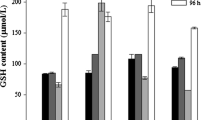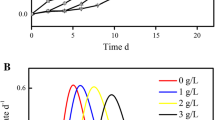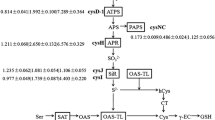Abstract
The response of Acidithiobacillus ferrooxidans to variations in extracellular Cu exposure was investigated in terms of glutathione-related genes expression profiling based on reverse-transcription quantitative PCR analysis. The results show that the higher concentration of Cu would induce the expression of glutathione-related enzymes and cells elicited specific transcriptional responses when challenged with environmental Cu (0.08 mol l−1) conditions over a 60-min period. In comparison to the control, glutathione S-transferases (GST) and glutathione reductase (GR) were highly expressed when the cells were grown in the medium with copper, and the increase of glutathione and glutathione-related enzymes makes the cells acclimate to oxidative stress induced by Cu and protects the cells from toxicity caused by Cu exposure. It suggests that in order for Acidithiobacillus ferrooxidans to counteract the conditions of external Cu exposure, it modulated its expression level of GST, GR, glutathione hydrolase, and glutathione synthetase, which may protect organisms from oxidative damage. These parameters may be used to assess the biological impact of Cu in mining activities.

Similar content being viewed by others
References
Alvarez S, Jerez CA (2004) Copper ions stimulate polyphosphate degradation and phosphate efflux in Acidithiobacillus ferrooxidans. Appl Environ Microbiol 70:5177–5182
Batist G, Tulpule A, Sinha BK et al (1986) Overexpression of a novel anionic glutathione transferase in multidrugresistant human breast cancer cells. J Biol Chem 33:15544–15549
Boojar MMA, Goodarzi F (2007) The copper tolerance strategies and the role of antioxidative enzymes in three plant species grown on copper mine. Chemosphere 67:2138–2147
Creissen GP, Edwards EA, Mullineaux PM (1994) Glutathione reductase and ascorbate peroxidase. In: Foyer CH, Mulineaux PM (eds) Causes of photooxidative stress and amelioration of defence systems in plants. CRC Press, Boca Raton, pp 343–364
Dahl N, Pigg M, Ristoff E et al (1997) Missense mutations in the human glutathione synthetase gene result in severe metabolic acidosis, 5-oxoprolinuria, hemolytic anemia and neurological dysfunction. Hum Mol Genet 6:1147–1152
Ding Y, Miao JL, Li GY et al (2005) Effect of Cd on GSH and GSH-related enzymes of Chlamydomonas sp. ICE-L existing in Antarctic ice. J Environ Sci 17:667–671
Dixit V, Pandey V, Shyam R (2001) Differential antioxidative responses to cadmium in roots and leaves of pea (Pisum sativum L cv Azad). J Exp Bot 52(358):1101–1109
Dopson M, Baker-Austin C, Koppineedi PR et al (2003) Growth in sulfidic mineral environments: metal resistance mechanisms in acidophilic microorganisms. Microbiology 149:1959–1970
Flohe L, Günzler WA (1984) Assays of glutathione peroxidase. Methods Enzymol 105:114–121
Foyer CH, Lelandas M, Galap C et al (1991) Effects of elevated cytosolic glutathione reductase activity on the cellular glutathione pool and photosynthesis in leaves under normal and stress condition. Plant Physiol 97:863–872
He H, Zhang C-G, Xia J-L et al (2009) Investigation of elemental sulfur speciation transformation mediated by Acidithiobacillus ferrooxidans. Curr Microbiol 58(4):300–307
Hegedus A, Erdei S, Horvath G (2001) Comparative studies of H2O2 detoxifying enzymes in green and greening barley seedlings under cadmium stress. Plant Sci 160:1085–1093
Iannelli MA, Pietrini F, Fiore L et al (2002) Antioxidant response to cadmium in Phragmites australis plants. Plant Physiol Biochem 40:977–982
Ingledew WJ (1982) Thiobacillus ferrooxidans: the bioenergetics of an acidophilic chemolithotroph. Biochim Biophys Acta 683:89–117
Karmakar R, Chatterjee M (1998) Cadmium-induced time-dependent oxidative stress in liver of mice: a correlation with kidney. Environ Toxicol Pharm 6:201–207
Kim SJ, Kim HG, Kim BC et al (2003) Regulation of the gene encoding glutathione synthetase from the fission yeast. J Biochem Mol Biol 36:326–331
Kim SJ, Kim HG, Kim BC et al (2004) Transcriptional regulation of glutathione synthetase in the fission yeast Schizosaccharomyces pombe. Mol Cells 18:242–248
Lee MY, Shin HW (2003) Cadmium-induced changes in antioxidant enzymes from the marine alga Nannochloropsis oculata. J Appl Phycol 15:13–19
Luo YJ, Liu YD, Zhang CG et al (2008) Insights into two high homogenous genes involved in copper homeostasis in Acidithiobacillus ferrooxidans. Curr Microbiol 57:274–280
Natarajan KA, Sudeesha K, Rao GR (1994) Stability of copper tolerance in Thiobacillus ferrooxidans. Anton Leeuw Int J G 66:303–306
Paulino LC, de Mello MP, Ottoboni LMM (2002) Differential gene expression in response to copper in Acidithiobacillus ferrooxidans analyzed by RNA arbitrarily primed polymerase chain reaction. Electrophoresis 23:520–527
Rawlings DE (2005) Characteristics and adaptability of iron- and sulfur-oxidizing microorganisms used for the recovery of metals from minerals and their concentrates. Microb Cell Fact 4:13
Rennenberg H (1982) Glutathione metabolism and possible biological roles in higher plants. Phytochemistry 21:2771–2781
Sheweita SA (1998) Heavy metal-induced changes in the glutathione levels and glutathione reductase/glutathione s-transferase activities in the liver of male mice. Int J Toxicol 17:383–392
Stadtman ER, Oliver CN (1991) Metal-catalyzed oxidation of proteins. J Biol Chem 266:2005–2008
Sugiyama K, Izawa S, Inoue Y (2000) The Yap1p dependent induction of glutathione synthesis in heat shock response of Saccharomyces cerevisiae. J Biol Chem 275:15535–15540
Xiang CB, David J (1998) Oliver glutathione metabolic genes coordinately respond to heavy metals and jasmonic acid in Arabidopsis. Plant Cell 10:1539–1550
Yamada T, Hiraoka Y, Gupta TK (2004) Rusticyanin, a bacterial electron transfer protein, causes G1 arrest in J774 and apoptosis in human cancer cells. Cell Cycle 3:1182–1187
Acknowledgments
This work was supported by the National Natural Science Foundation of China (No. 50674101), the National Basic Research Program of China (No. 2004CB619201), and the Chinese Science Foundation for Distinguished Group (No. 50621063).
Author information
Authors and Affiliations
Corresponding author
Rights and permissions
About this article
Cite this article
Xia, Jl., Wu, S., Zhang, Ry. et al. Effects of Copper Exposure on Expression of Glutathione-Related Genes in Acidithiobacillus ferrooxidans . Curr Microbiol 62, 1460–1466 (2011). https://doi.org/10.1007/s00284-011-9881-9
Received:
Accepted:
Published:
Issue Date:
DOI: https://doi.org/10.1007/s00284-011-9881-9




